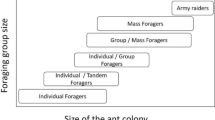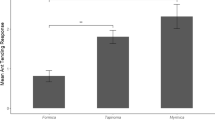Summary
(1) The giant tropical ant, Paraponera clavata, exhibits graded recruitment responses, depending on the type, quantity, and quality of a food source. More ants are initially recruited to a large prey or scavenge item than to a large quantity of sugar water. (2) Individual ants encountering prey items gauge the size and/or unwieldiness of the item, regardless of the weight, when determining whether to recruit. (3) The trail pheromone of this species is often used as an orientation device by individual ants, independent of recruitment of nestmates. (4) It is proposed that the foraging behavior of P. clavata represents one of the evolutionary transitions from the independent foraging activities of the primitive ants to the highly coordinated cooperative foraging activities of many “higher” ants.
Similar content being viewed by others
References
Attygale AB, Morgan ED (1985) Ant trail pheromones. Adv Ins Physiol 18:1–30
Breed MD, Bennett B (1985) Mass recruitment to nectar sources in Paraponera clavata: A field study. Insectes Soc 32:198–208
Chadab R, Rettenmeyer CW (1975) Mass recruitment by army ants. Science 188:1124–1125
Crawford DL, Rissing SW (1983) Regulation of recruitment by individual scouts in Formica oreas Insectes Soc 30:177–183
Hangartner W (1969) Structure and variability of the individual odor trail in Solenopsis geminata. Z Vergl Physiol 62:111–120
Haskins CP, Haskins EF (1950) Notes on the biology and social behavior of the archaic ponerine ants of the genera Myrmecia and Promyrmecia. Ann Entomol Soc Am 43:461–491
Hölldobler B (1971) Recruitment behavior in Camponotus socius. Z Vergl Physiol 75:123–142
Hölldobler B (1974) Communication by tandem running in the ant Camponotus sericeus. J Comp Physiol 90:105–127
Hölldobler B (1976) Recruitment behavior, home range orientation and territoriality in harvester ants, Pogonomyrmex. Behav Ecol Sociobiol 1:3–44
Hölldobler B (1978) Ethological aspects of chemical communication in ants. Adv Study Behav 8:75–115
Hölldobler B (1984) The evolution of insect communication. In: Lewis T (ed) Insect communication, Academic Press, New York, pp 349–377
Hölldobler B, Stanton R, Markl H (1978) Recruitment and food-retrieving behavior in Novomessor. Behav Ecol Sociobiol 4:163–181
Hölldobler B, Wilson EO (1970) Recruitment trails in the harvester ant Pogonomyrmex badius. Psyche 77:385–399
Janzen DH, Carroll CR (1983) Paraponera clavata. In: Janzen DH (ed) Costa Rican Natural History. University of Chicago Press, Chicago, pp 752–753
Jaffe K, Howse PE (1978) The mass recruitment system of the leaf cutting ant, Atta cephalotes. Anim Behav 27:930–939
Jessen K, Maschwitz U (1985) Individual specific trails in the ant Pachycondyla tesserinoda. Naturwissenschaften 72:549–550
Markl H, Hölldobler B (1978) Recruitment and food-retrieving behavior in Novomessor. Behav Ecol Sociobiol 4:183–216
Michener CD (1974) The comparative social behavior of the bees. Harvard University Press, Cambridge, Mass
Möglich M, Hölldobler B (1975) Communication and orientation during foraging and emigration in the ant, Formica fusca. J Comp Physiol 101:275–288
Oster G, Wilson EO (1978) Caste and ecology in social insects. Princeton University Press, Princeton
Taylor FJ (1978) Foraging behavior of ants: theoretical considerations. J Theor Biol 71:541–565
Traniello JFA (1977) Recruitment behavior, orientation, and the organization of foraging in the Carpenter ant Camponotus pennsylvanicus. Behav Ecol Sociobiol 2:61–79
Wilson EO (1962) Chemical communication among workers of the fire ant, Solenopsis saevissima. Anim Behav 10:134–164
Wilson EO (1971) The insect societies. Harvard University Press, Cambridge, Mass
Young AM, Hermann HR (1980) Notes on the foraging of the giant tropical ant, Paraponera clavata J Kansas Entomol Soc 53:32–55
Author information
Authors and Affiliations
Rights and permissions
About this article
Cite this article
Breed, M.D., Fewell, J.H., Moore, A.J. et al. Graded recruitment in a ponerine ant. Behav Ecol Sociobiol 20, 407–411 (1987). https://doi.org/10.1007/BF00302983
Received:
Accepted:
Issue Date:
DOI: https://doi.org/10.1007/BF00302983




